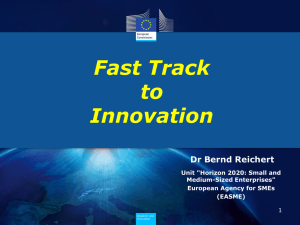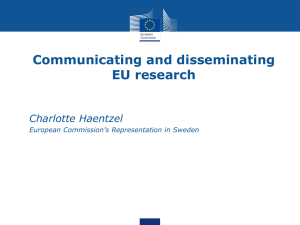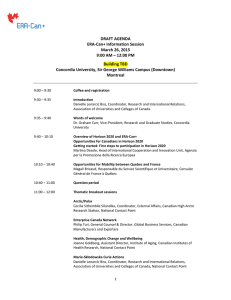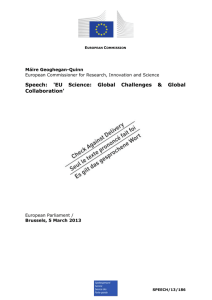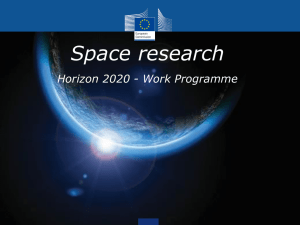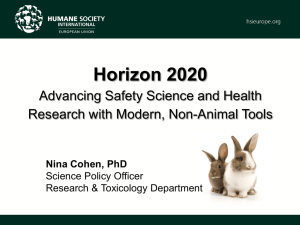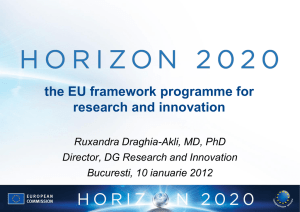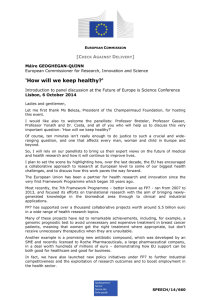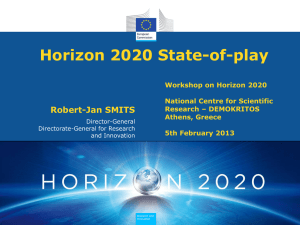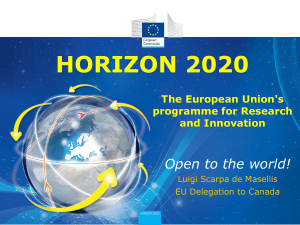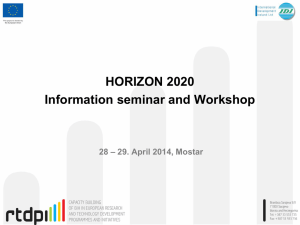Horizon 2020 and partnering
advertisement
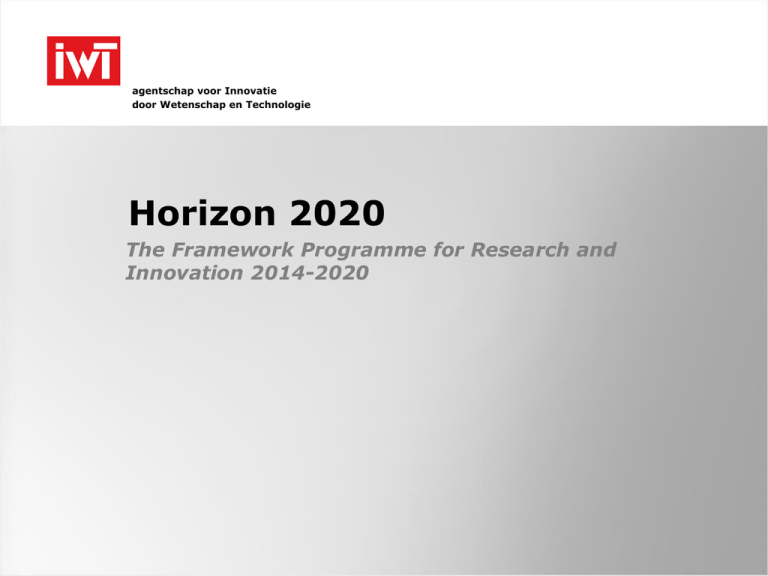
agentschap voor Innovatie door Wetenschap en Technologie Horizon 2020 The Framework Programme for Research and Innovation 2014-2020 Fundamental Research Pillar 1: technological research Pillar 2: Product demonstration Horizon 2020 (TRL 1 – 8) European Regional Development Fund (TRL 2 – 9) European Investment Bank (TRL 2 – 9) Pillar 3: Competitive Manufacturing Horizon 2020 Basics • A single programme bringing together three separate programmes/initiatives (FP/CIP/EIT) • Coupling research to innovation – from research to retail, all forms of innovation (integration of the innovation dimension) • Focus on societal challenges facing EU society, e.g. health, clean energy and transport • Additional emphasis on Public-Private-Partnerships and PublicPublic-Partnerships • New approaches to SME support Europe 2020 priorities Shared objectives and principles European Research Area International cooperation Tackling Societal Challenges • Health, demographic change and wellbeing • Food security, sustainable agriculture and forestry, marine, maritime and inland water research and the bio-economy • Secure, clean and efficient energy • Smart, green and integrated transport • Climate action, environment, resource efficiency and raw materials • Europe in a changing world - Inclusive, innovative and reflective societies • Secure societies – Protecting freedom and security of Europe and its citizens Creating Industrial Leadership and Competitive Frameworks • Leadership in enabling and industrial technologies • Information and communication technologies • Nanotechnologies, advanced materials, advanced manufacturing and processing and biotechnology • Space • Access to risk finance • Innovation in SMEs Excellence in the Science Base • European Research Council • Future and Emerging Technologies • Marie Slodowska-Curie actions • European research infrastructures, including e-Infrastructures Dissemination and Simplified access Knowledge transfer Common rules, toolkit of funding schemes 4 Horizon 2020 Budget breakdown (2013/09) 5 Societal Challenges – Budget breakdown (in million EUR) 6 Horizon 2020 vs. TRL (Technology Readiness Level) 7 Horizon 2020 is different • a strong challenge-based approach • simplified list of possible types of action (e.g. research and innovation – 100%; innovation actions – 70%) • less prescription, strong emphasis on expected impact • broader topics • cross-cutting issues mainstreamed (e.g. ICT, social sciences, gender) 8 Horizon 2020 and partnering (I) Public-Public Partnerships (P2Ps): • Through “ERA-Nets” for topping up individual calls/ actions (replacing current ERA-Net, ERA-Net Plus, Inco-Net, Inno-net) • Through participation in joint programs between Member States (art 185, e.g. EUROSTARS, AAL) • Supporting agendas of Joint Programming Initiatives when in line with Horizon 2020, e.g. JP Neurodegeneratieve Aandoeningen, JP Urban Europe • Only when criteria met, e.g. financial commitments of participating countries • “Smart specialisation” 9 Horizon 2020 and partnering (II) Public-Private Partnerships (PPPs): • Through Joint Technology Initiatives (JTI) or other formal structures (art 187.), e.g. Artemis/Eniac, • Via contractual arrangements, which provide inputs for work programmes • Only when criteria met, e.g. clear commitments from private partners European Innovation Partnerships • Not funding instruments, but for coordination with broader policies and programmes Rules of participation: simplification A single set of rules: • adapted for the whole research and innovation cycle • aligned to the Financial Regulation, coherent with other new EU Programmes Simpler rules for grants: • broader acceptance of participants accounting practices for direct costs, • flat rate for indirect costs, Fewer, better targeted controls and audits: • audit strategy focused on risk and fraud prevention • new balance between trust and control 11 Conditions for participation Minimum conditions Standard collaborative actions: At least 3 legal entities established in different MS or AC ERC, SME instrument, programme Co-Fund, coordination & support, training & mobility actions: One legal entity established in MS or AC Additional conditions In the work programme or work plan 12 Evaluation of proposals Standard criteria Excellence Impact Quality & efficiency of the action ERC frontier research actions: only “Excellence” Innovation actions: higher weighting for “Impact” 13 Time to grant: speeding up the process A maximum of TTG of 8 months 5 months for informing all applicants on scientific evaluation 3 months for signature of GA (Grant Agreement) How to speed up the process No more negotiations: each proposal evaluated ‘as it is’ and not as ‘what could be’ Legal entity validated in parallel No more paper 14 H2020: SINGLE FUNDING RATE Maximum reimbursemen t rates Research and technological development activities (*) Network of excellence 50% 75% Collaborative project(****) 50% 75% Coordination and support action Demonstration activities One project = One rate Other activities 100% 50% 100% Same rate for all beneficiaries and all 100% activities in the grant The applicable rate will be defined in the Work Programme Up to 100 % of the eligible costs but limited to a maximum of 70 % for innovation projects “close to market” (exception for non-profit organisations – max. of 100 %) H2020 COST REIMBURSEMENT: indirect costs 60% ? 20% ? 25 % flat- Real ? Simplified? rate agentschap voor Innovatie door Wetenschap en Technologie Koning Albert II-laan 35, bus 16 B-1030 Brussel Tel.: +32 (0)2 432 42 00 Fax.: +32 (0)2 432 43 99 E-mail: info@iwt.be www.iwt.be

